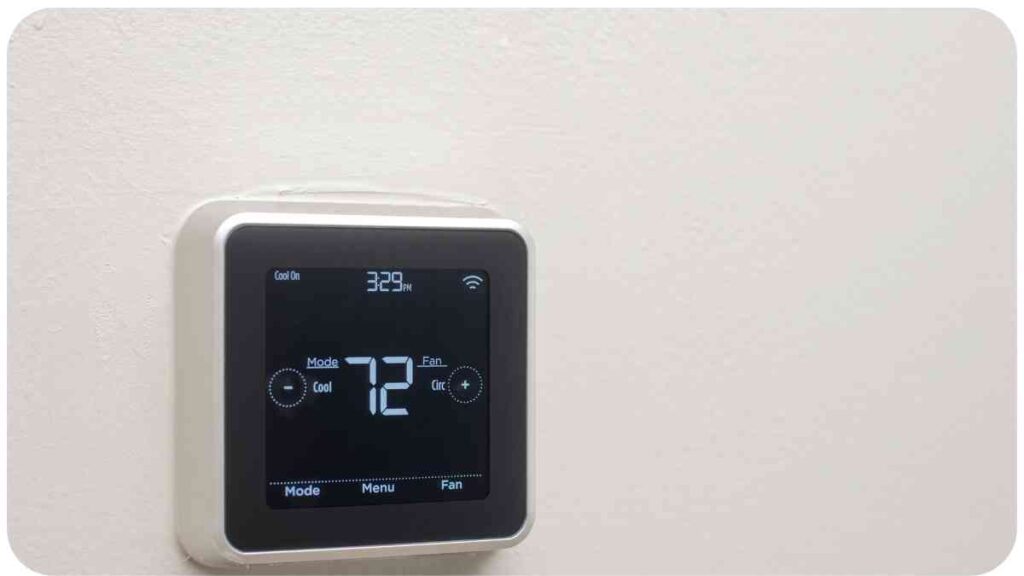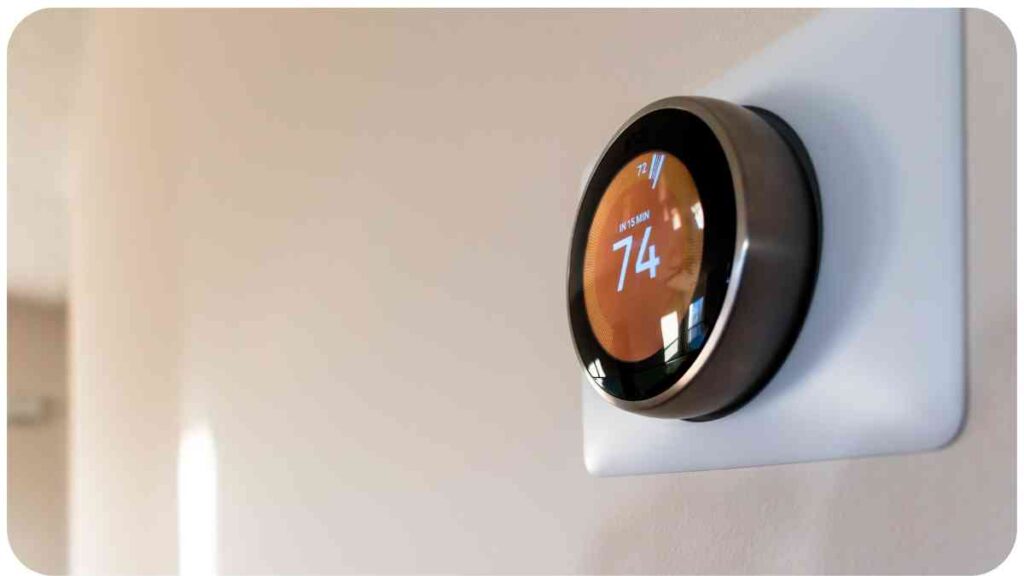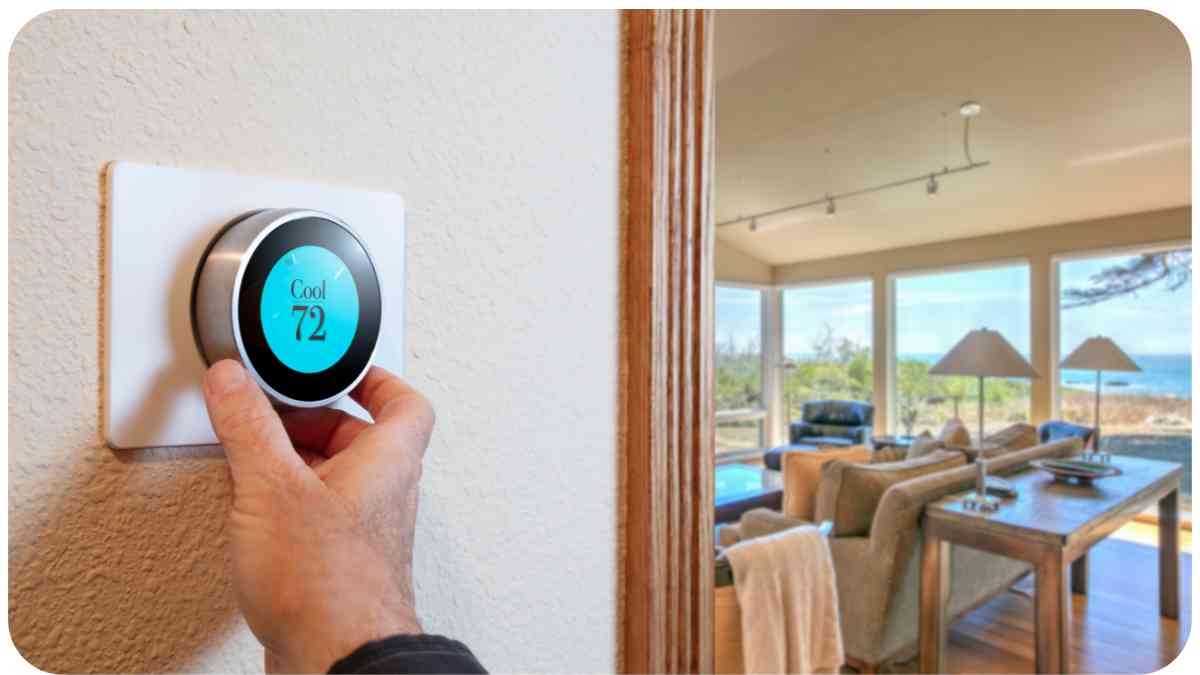As we embark on this era of sustainability, the tools we use to achieve an eco-friendly lifestyle are becoming increasingly advanced. Why Smart Thermostats? Well, in a world where every penny and kilowatt-hour counts, these nifty devices have emerged as a beacon of both financial savings and environmental consciousness.
The Rise of Sustainable Living isn’t just a trend—it’s a necessary shift. With the looming threat of climate change, households around the world are recognizing the need to make smart choices. And as someone deeply embedded in the industry, I’ve witnessed firsthand the transformative power of tech like smart thermostats.
Table: Evolution of Home Thermostats
| Era | Type of Thermostat | Key Features |
| 1950s-70s | Mechanical Thermostats | Manual dial, mercury-based |
| 1980s-90s | Digital Thermostats | LCD Display, Programmable settings |
| 2000s | Programmable Thermostats | Multiple daily settings, Energy-saving features |
| 2010s-Present | Smart Thermostats | Remote control, Learning capabilities, Integration with other smart devices |
What is a Smart Thermostat?

Diving right in, a Smart Thermostat is more than just a device to set your home’s temperature. It’s a gateway to Core Features and Benefits like energy tracking, automated heating/cooling, and even predictive adjustments based on your routine. How cool is that? (Pun intended!)
How Does It Work? At its core, these thermostats connect to your home’s Wi-Fi, allowing remote control via smartphones or computers. But it’s more than just remote access. Some learn from your behaviors, auto-adjusting to save energy. Others integrate with weather forecasts to make informed heating or cooling decisions. Imagine a device that knows it’s about to get chilly and warms your home right before you arrive. That’s smart living.
Table: Differences between Traditional and Smart Thermostats
| Feature | Traditional Thermostats | Smart Thermostats |
| Connectivity | None | Wi-Fi, Bluetooth |
| Control | Manual | Remote via App, Voice Commands |
| Energy Tracking | No | Yes |
| Learning Capability | No | Yes |
| Integration | Standalone | Connects with other smart devices |
Energy Efficiency and Cost Savings
So, How Much Can You Really Save? Well, it’s more significant than you might think. On average, households report about a 10-20% reduction in their heating and cooling costs after installing a smart thermostat. Do the math, and that’s potentially hundreds of dollars annually.
Let me share a Personal Anecdote: My First Month with a Smart Thermostat. After the initial setup, I was skeptical. But, to my surprise, by month’s end, my energy bill had plummeted by 15%! And the best part? I didn’t feel any less comfortable in my home. The thermostat just knew when to cut corners without cutting comfort.
When striving for eco-friendly living, remember that small changes can make a big difference. Implementing tips like using LED bulbs and reducing water waste can contribute to creating a green and sustainable home, ultimately benefiting both your wallet and the planet.
Table: Estimated Monthly Savings from Using a Smart Thermostat
| Month | Traditional Bill | Smart Thermostat Bill | Savings |
| January | $150 | $127.50 | $22.50 |
| February | $145 | $123.25 | $21.75 |
| March | $130 | $110.50 | $19.50 |
(Note: These are illustrative figures and actual savings may vary based on many factors.)
Integration with Smart Home Systems
Advantages of a Connected Home are vast. Imagine your lights, security system, and thermostat all communicating. It’s like having a symphony of devices working in harmony to enhance your comfort, safety, and energy efficiency. The age of isolated gadgets is over; the interconnected smart home era is here.
Let me narrate my Personal Experience: Setting Up My Smart Home. I remember the early days of smart tech – separate apps for every device, and none of them spoke to each other. Then I integrated my smart thermostat with my home system. Suddenly, my lights dimmed when the sun set, my home warmed up before I got back from work, and I got alerts if something seemed amiss. It’s not just convenient—it’s transformative.
Table: Popular Smart Home Systems and Their Compatibility
| Smart Home System | Compatible with Smart Thermostats? | Notable Features |
| Google Home | Yes | Voice control, Routine Setting |
| Amazon Alexa | Yes | Voice commands, Wide device compatibility |
| Apple HomeKit | Yes | Seamless integration with Apple devices, Security features |
| Samsung SmartThings | Yes | Wide compatibility, SmartThings app control |
Selecting the Right Smart Thermostat for Your Home
Factors to Consider are plentiful: the size of your home, the type of heating system you use, your daily routines, and even aesthetic preferences can all influence the right choice for you. After all, this isn’t just a gadget—it’s an addition to your living space and lifestyle.
Expert Recommendations? Certainly! After years in the industry and seeing countless models come and go, I can confidently point you to some of the best in the market.
For those looking to minimize their energy consumption and environmental impact, understanding the importance of energy-efficient appliances is key. This guide outlines how choosing the right appliances can lead to significant cost savings and a more sustainable lifestyle.
Table: Top 5 Smart Thermostats in 2023
| Rank | Brand and Model | Key Features | Average Price |
| 1 | Nest Learning Thermostat | Self-learning, Energy Reports, Stylish design | $250 |
| 2 | Ecobee SmartThermostat | Alexa built-in, SmartSensors, Energy-saving | $240 |
| 3 | Honeywell Home T9 | Room-by-room focus, Long battery life | $200 |
| 4 | Emerson Sensi Touch | Affordable, Geofencing, Easy installation | $170 |
| 5 | Lux Geo | Geofencing, Multiple power options, Budget-friendly | $120 |
Installation and Setup

When it comes to DIY vs. Professional Installation, the choice largely hinges on your comfort with tech. While most smart thermostats tout easy self-installation, some homes or systems might require a pro’s touch. Remember that time when I thought I had perfectly set up my unit, only to find I’d missed a crucial step? It happens!
Common Challenges and How to Overcome Them: From connectivity issues to software updates, it’s essential to know what hurdles you might face.
Table: Step-by-Step Installation Guide
| Step | Instructions |
| 1 | Turn off your current system’s power (Safety first!) |
| 2 | Remove the old thermostat, but take a photo of the wiring for reference. |
| 3 | Install the new thermostat base, using the included labels for wires. |
| 4 | Connect to Wi-Fi and set up via the thermostat’s app. |
| 5 | Configure your preferences, schedules, and integrate with other devices if needed. |
(Note: Always refer to the specific model’s manual for detailed steps and safety precautions.)
User Experience and Feedback
What Are People Saying? The buzz around smart thermostats isn’t just industry hype; real users are reaping real benefits. From saving money to enhancing comfort, there’s a plethora of user experiences that highlight the positives and, yes, the occasional negatives.
A little Personal Insights: 6 Months into Using My Smart Thermostat: At first, the novelty was intriguing. But six months in, it became clear – this was no mere novelty. My energy bills were consistently lower, my home always felt just right, and on the rare chilly morning, my house would be toasty warm before my feet hit the floor.
Creating an energy-efficient home doesn’t have to break the bank. By following these budget-friendly tips, you can reduce energy consumption and lower your utility bills while taking a step towards a more sustainable and eco-friendly lifestyle.
Table: User Ratings and Reviews of Top Smart Thermostats
| Brand and Model | Average User Rating (Out of 5) | Top Positive Review | Top Constructive Critique |
| Nest Learning Thermostat | 4.7 | “Learns my routine seamlessly!” | “Wish it integrated better with non-Google devices.” |
| Ecobee SmartThermostat | 4.6 | “The inbuilt Alexa is a game-changer!” | “The app could be more intuitive.” |
| Honeywell Home T9 | 4.5 | “Room-by-room focus is amazing!” | “Initial setup took a bit longer than expected.” |
Maintenance and Troubleshooting
Keeping Your Thermostat in Top Shape isn’t a chore. Most smart thermostats require minimal maintenance. However, like all tech, they aren’t entirely immune to issues.
A Personal Anecdote: When My Thermostat Acted Up: One wintry morning, I woke up to an unusually chilly house. The thermostat screen was blank! Panicked, I reached out to customer support, only to learn it was a simple software glitch. A quick restart, and I was back in cozy business.
Table: Common Issues and Their Solutions
| Common Issues | Potential Solutions |
| Blank screen | Check power source, try a soft reset. |
| Not connecting to Wi-Fi | Reset the Wi-Fi connection, ensure router is functioning. |
| Inaccurate temperature readings | Ensure no heating sources are near the thermostat, recalibrate if necessary. |
Environmental Impact
Beyond our wallets, smart thermostats are making a difference in the bigger picture – our planet. Reducing Carbon Footprint isn’t just a buzzword; it’s a tangible outcome of using these devices.
But let’s look at the Broader Picture of Sustainability. These thermostats, when multiplied by millions of households, can significantly reduce the strain on our power grids and decrease overall energy consumption.
Table: Environmental Savings from Using Smart Thermostats
| Environmental Factor | Traditional Usage | Smart Thermostat Impact | Estimated Annual Savings |
| Carbon Emissions (in tons) | 3.5 | -20% | 0.7 tons |
| Energy Consumption (in kWh) | 10,000 | -15% | 1,500 kWh |
Future of Smart Thermostats

Ah, the horizon! The Innovations on the Horizon are tantalizing. As technology grows, so too will the capabilities of these smart devices.
Integration with Renewable Energy Sources: Some models are now working in tandem with solar panels, ensuring optimal energy use throughout the day.
Table: Upcoming Features in Next-Gen Thermostats
| Upcoming Features | Brief Description |
| Solar Integration | Sync with solar panel energy generation for maximum efficiency. |
| AI-enhanced Learning | Even more nuanced learning based on household behavior. |
| Enhanced Voice Controls | Understands more commands and integrates with multiple voice assistants. |
Financial Incentives and Rebates
Making the switch to a smart thermostat doesn’t just save you monthly on energy bills. There’s an initial boost too! Many regions and energy companies offer Financial Incentives and Rebates to encourage the adoption of these energy-saving devices.
Making the Switch More Affordable: Initially, the price tag of a smart thermostat might seem steep, especially for top-tier models. However, once you factor in available rebates, the cost becomes much more palatable.
Table: Available Rebates by Region
| Region | Available Rebate | Conditions |
| California, USA | Up to $50 | Must be installed in a primary residence |
| Ontario, Canada | Up to $75 | Should be integrated with a smart home system |
| London, UK | Up to £40 | Need to show energy savings post-installation |
| New South Wales, Australia | Up to AUD 60 | Applicable only for certain approved brands |
FAQs about Smart Thermostats
Given their popularity, there’s an array of questions floating around about smart thermostats. Addressing Common Concerns is vital to help potential users make an informed decision.
Efficiency is the secret to reducing your environmental impact. Learn how to reduce your carbon footprint with smart choices and effective strategies. By prioritizing efficiency, you can make a positive change for the planet and your own well-being
Table: Frequently Asked Questions and Answers
| FAQs | Answers |
| Are smart thermostats hard to install? | Most are designed for easy DIY installation, but it may vary depending on your home’s system. |
| Will it really reduce my energy bill? | Yes! While savings vary, many users report a 10-20% reduction in heating and cooling costs. |
| Can I control it when I’m away from home? | Absolutely. With a Wi-Fi connection, you can adjust settings from anywhere via a smartphone app. |
Expert Tips for Maximizing Benefits
While the automatic features of smart thermostats are impressive, there are ways to optimize their benefits further. Here are some Getting the Most Out of Your Device insights.
From my journey, a key learning has been to regularly review energy consumption reports. These can highlight patterns and suggest tweaks to save even more.
Personal Tips from My Journey:
- Regular Updates: Always keep your device’s software updated to leverage the latest energy-saving algorithms.
- Integration: The more you integrate with other smart devices, the more holistic the energy savings.
- Feedback: These devices learn from patterns, so the more you interact and provide feedback, the better they adapt to your preferences.
The Role of Smart Thermostats in a Sustainable World
It’s not just about the individual benefits; it’s about the Big Picture Benefits. Smart thermostats, when looked at collectively, are playing a pivotal role in global energy conservation efforts.
Table: Global Impact Statistics
| Impact Factor | Stats Without Smart Thermostats | With Mass Adoption of Smart Thermostats |
| Annual Global Energy Consumption | 160,000 TWh | 144,000 TWh (10% Reduction) |
| CO2 Emissions from Heating/Cooling | 6 Billion Metric Tons | 5.4 Billion Metric Tons (10% Reduction) |
| Average Household Energy Costs | $1,500/year | $1,350/year (10% Savings) |
Conclusion
Reflecting on the journey we’ve taken in this article, it’s evident that smart thermostats are more than just a technological novelty. They stand at the intersection of comfort, cost savings, and a cleaner environment. In a world where every bit counts towards a sustainable future, making a switch is not just a smart choice for households but a wise one for our planet.
With the continuous evolution of these devices, one can only anticipate even greater advancements and benefits. So, as you ponder on taking the leap, remember, it’s not just about adjusting the temperature; it’s about setting the right climate for the future.
Planning a trip? Explore the world while staying environmentally conscious with this comprehensive guide to sustainable travel. Discover eco-friendly travel tips and practices that allow you to enjoy your adventures while minimizing your impact on the planet
Further Reading
Interested in diving deeper into the world of smart thermostats and sustainable living? Here are some recommended articles that shed more light on the subject:
- Google Store – Nest Thermostat Savings
- A detailed look into the savings potential when using the Nest Learning Thermostat. Google offers insights into the device’s efficiency and user benefits.
- Smart Thermostats: A Solution or Part of the Problem?
- This article delves into the pros and cons of smart thermostats, questioning their role in modern energy consumption patterns.
- Sustainable Living: A Look at Thermostat Practices and the Environment
- Explore the intersection of thermostat use, energy conservation, and environmental impact. A must-read for those interested in sustainability.
FAQs
Are Smart Thermostats Really Energy Efficient?
Smart thermostats are designed to optimize energy use based on your preferences and habits. Over time, they “learn” and adjust, leading to more efficient heating and cooling.
How Do Smart Thermostats Benefit the Environment?
By reducing unnecessary heating and cooling, smart thermostats reduce energy consumption, leading to fewer CO2 emissions and a smaller carbon footprint.
Are There Financial Incentives for Using Smart Thermostats?
Yes, many regions and energy companies offer rebates and incentives to encourage the adoption of energy-saving devices like smart thermostats.
How Does a Smart Thermostat Integrate with Other Smart Devices?
Most smart thermostats can connect with various home automation systems, allowing for seamless integration with lights, security systems, and more.
What’s the Difference Between a Programmable Thermostat and a Smart Thermostat?
While both allow for setting temperature schedules, smart thermostats offer more advanced features like learning your habits, remote control via smartphones, and integration with other smart devices.

I am Hellen, I’ve been passionate about sustainability for as long as I can remember. It’s something that my mom taught me from a young age, and it’s something that has shaped my life in so many ways.

